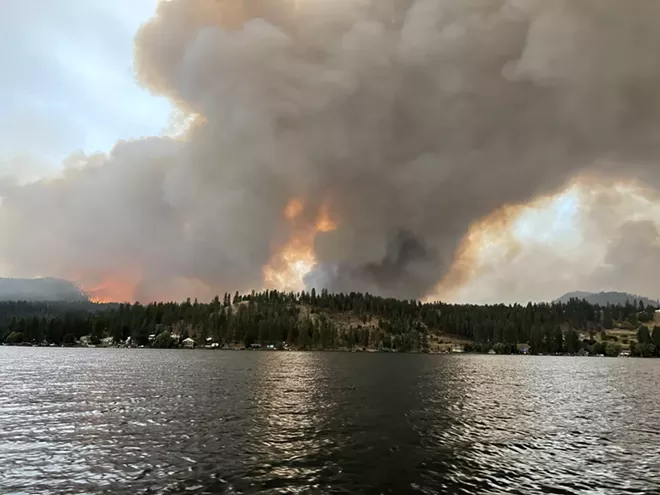
The latest smoky Spokane weekend turned the sky a dystopic shade of gray and pushed the air quality well above the “unhealthy” category. The smoke wasn’t enough to stop Primus from performing, but it did halt the Northwest Cup soccer tournament and a number of other activities.
It wasn’t always this bad. Jamie Bowman, a family medicine physician and Clinical Education Director at WSU, started practicing medicine in Eastern Washington 16 years ago. Back then, she says the smoke wasn’t as much of an issue, but in recent years an increasing number of patients have come to her with concerns about the health impacts of the smoke.
“Not only are people experiencing more awareness and symptoms related to it, they’re also thinking strategically about what they can do to protect themselves, what they can do to take care of the more vulnerable folks in their life,” Bowman says, “whether that’s people who have underlying conditions, children or elderly.”
When the air quality passes 150 AQI, it gets categorized as unhealthy for the general population. On Friday, the air quality passed 200 AQI and veered into “very unhealthy” territory. When the AQI passes 150, even healthy young people can start experiencing symptoms. That includes things like watering eyes, sneezing, coughing and shortness of breath, Bowman says.
Bowman recommends IQAir.com as the best source for up-to-date air quality information. When it starts getting into the dark red “unhealthy” category, she recommends limiting the amount of time spent outside, even for non-vigorous activities. If you start to notice symptoms like coughing or stinging eyes, it’s a good idea to relocate inside, ideally in a room with some sort of air filter.
But while the short-term impacts of wildfire smoke are well documented, there’s still a lot we don’t know about the long-term effects.
Chris Migliaccio, a researcher at the University of Montana, worked on a study that tracked the long-term effects of wildfire smoke exposure in Seeley Lake, a small town in Montana. In 2017, wildfire smoke enveloped the residents of Seeley Lake for 49 days. Seeing a rare opportunity to study the long-term impact, Migliaccio and a team of researchers travelled to town and started measuring the resident’s health. Immediately after the fire, 10.2 percent of the residents had lung capacity below normal thresholds. When the researchers returned a year later, the number was 45.9 percent.
The same pattern is visible in mice. As part of his research, Migliaccio constructed a mouse enclosure that was pumped full of wood smoke. The researchers didn’t see any immediate effect on breathing rate, but two months later Migliaccio says they observed adverse effects on lung function.
“We’re still trying to get a handle on what the long-term implications are,” Migliaccio says. “If we go a handful of years without any wildfires, do we see it resolving or getting better? Or is this a cumulative effect? It’s all really new.”
Migliaccio’s research was among the first to examine the long-term effects of wildfire smoke on respiratory health. In the future, Migliaccio says he hopes to further explore the long-term effects of wildfire smoke on cardiovascular health.
The lack of research partially comes down to the previously unseen levels of smoke we’re experiencing.
“The current temperatures, and wildfires and therefore air quality issues that we’re having right now are a bit unprecedented. We haven’t ever seen anything like this before,” Bowman says.
Bowman says there’s a need to study not just the health effects, but also the social implications. How does wildfire smoke change the way we connect with people? How does it impact our relationship with physical activity? Going on a bike ride in smoky weather might come with health risks, but does it outweigh the negative effects of sitting inside and not exercising at all?
Those are questions Migliaccio hopes to answer. He is currently writing a grant with a colleague for research that will explore the contribution of activity on adverse effects from smoke.
“What we’d like to get at with these studies is being able to at least have some sort of a guide like, ‘OK, if the level is this, you can still get a benefit from exercising this much at this level,’” Migliaccio says.
Right now, the guidance for activity during smoke exposure is pretty black and white. Migliaccio says his daughters in high school are currently doing soccer tryouts. The tryouts proceed as normal all the way up to 149 AQI, but the minute it hits 150, the air is officially considered “unhealthy” and tryouts are moved inside.
Migliaccio hopes his future research can help introduce more nuance. Instead of an all-or-nothing cutoff, Migliaccio says research could help identify a more gradual approach to activity during smoky weather, perhaps with the intensity of activity correlating with the current AQI.
People who are eldery or have pre-existing conditions like asthma should be especially cautious, but Migliaccio says young healthy people have a bit more flexibility when it comes to physical activity.
“If your lungs and everything are really healthy, you could probably absorb some here and there and you might be OK in the short term, maybe even in the long term as long as you don’t run a marathon every single wildfire season,” Migliaccio says.
Migliaccio strongly advises against running a marathon every single wildfire season.
